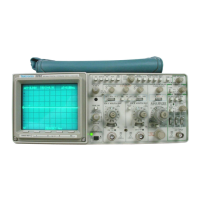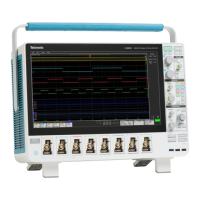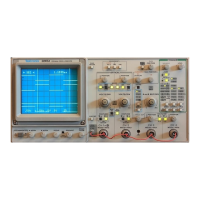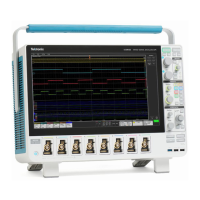Do you have a question about the Tektronix 3 Series and is the answer not in the manual?
| Vertical Sensitivity | 1 mV/div to 10 V/div |
|---|---|
| Sample Rate | 2.5 GS/s |
| Channels | 2 or 4 |
| Memory Depth | 10 Mpoints |
| Trigger Types | Edge, Pulse Width, Runt, Logic, Setup/Hold, Rise/Fall, Video |
| Connectivity | USB, LAN |
| Vertical Resolution | 8 bits |
Lists the key features and benefits of the 3 Series MDO oscilloscopes, highlighting its integrated capabilities.
Details various probes offered by Tektronix for different application needs, with part numbers.
Details the AFG option, adding a 50 MHz AFG function with various waveform types and features.
Covers options for serial bus decode and triggering for industry-standard serial buses.
Explains the power analysis option for measurements like power quality, switching loss, and harmonics.
Details how to add functionality to the 3 Series MDO after initial purchase using software license keys.
Explains how instrument bandwidth and spectrum analyzer frequency range can be upgraded post-purchase.
Describes the front panel controls and connectors providing access to key instrument settings and inputs.
Details how to use configuration menus to set parameters for channels, system settings, and measurements.
Procedure to verify the oscilloscope can display a waveform and take a measurement.
Instructions for updating the instrument's firmware to ensure optimal performance and features.
Guidance on running SPC at regular intervals for best measurement accuracy.
Procedure to adjust probe compensation for best waveform capture and measurement accuracy.
Steps to connect the instrument to a network for remote access and data transfer.
Procedure to visually align waveform edges to compensate for timing differences between probes.
Procedure to more accurately minimize timing differences between probes using a Delay measurement.
Procedure to set scale and position parameters for analog signal acquisition.
Procedure to open the Trigger menu to select and configure trigger event type and conditions.
Procedure to set the method the instrument uses to acquire and display the signal.
Procedure to select and add measurements to the Results bar.
Use the digital Channel configuration menu to set up digital channels for acquiring signals.
Sets pulse-width triggering to mark when a signal pulse width meets specific criteria.
Menu to add statistics and change measurement settings like source, levels, and gating.
Defines conditions to mark events on a channel or waveform signal.
Defines channel or waveform signal conditions for triggering the oscilloscope.
Configures the Waveform View for style, persistence, intensity, markers, and other parameters.
Explains the acquisition system, hardware, sampling process, and waveform records.
Describes the optional integrated arbitrary function generator (AFG) for signal simulation.
Provides an overview of user-defined trigger conditions for capturing waveforms.
Explains the flexible and customizable display for controlling how waveforms appear.
Covers automatic and manual measurements in time and frequency domains, and DVM measurements.
Explains how to take automatic measurements in the time domain.
Explains how to take automatic measurements in the frequency domain.
Guides on using on-screen cursors to take manual measurements on acquired data.
Procedure to take automatic power measurements using the 3-PWR option.
Explains how to use FFT to display a graph of the frequency domain of a signal.
Procedure to upgrade the instrument firmware using a USB flash drive or hard drive.












